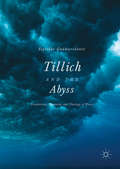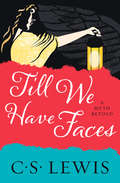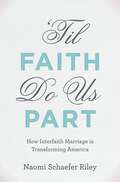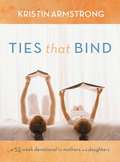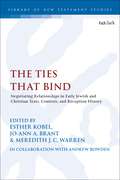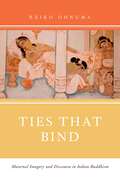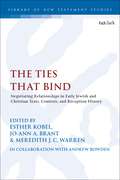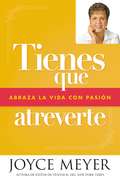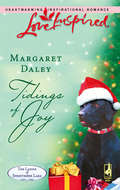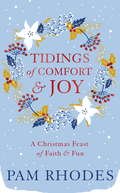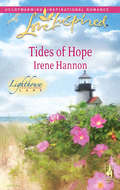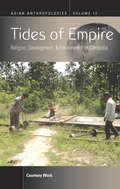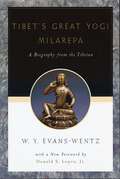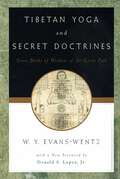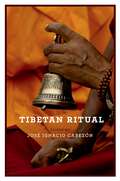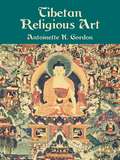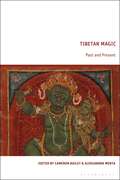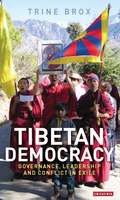- Table View
- List View
Tillich and the Abyss: Foundations, Feminism, and Theology of Praxis
by Sigridur GudmarsdottirThis book examines Paul Tillich´s theological concept of the abyss by locating it within the context of current postmodern antifoundalist discussions and debates surrounding feminism, gender, and language. Sigridur Gudmarsdottir develops these tropes into a constructive theology, arguing that Tillich’s idea of the abyss can serve as a necessary means of deconstructing the binaries between the theoretical and the practical in producing nihilistic relativism and the safe foundations of knowledge (divine as well as human).How does one search for a map and method through an abyss? In his writings, Tillich expressed the ambiguity and groundlessness of being, the depth structure of the human condition, and the reality of God as an abyss. The more we gaze into this abyss, the more we encounter the faults in our various foundations. This book outlines how Tillich’s concept of the abyss creates greater opportunities for complexity and liminality and opens up a space where life and death, destruction and construction, fecundity and horror, womb and tomb, can coincide.
Till We Have Faces: A Myth Retold (G. K. Hall Perennial Bestsellers Ser.)
by C. LewisFascinated by the myth of Cupid and Psyche throughout his life, C. S. Lewis reimagines their story from the perspective of Psyche’s sister, Orual. ‘I saw well why the gods do not speak to us openly, nor let us answer . . . Why should they hear the babble that we think we mean? How can they meet us face to face till we have faces?’ Till We Have Faces is a brilliant examination of envy, betrayal, loss, blame, grief, guilt, and conversion. In this, his final – and most mature and masterful – novel, Lewis reminds us of our own fallibility and the role of a higher power in our lives.
'Til Faith Do Us Part: How Interfaith Marriage is Transforming America
by Naomi Schaefer RileyIn the last decade, 45% of all marriages in the U.S. were between people of different faiths. The rapidly growing number of mixed-faith families has become a source of hope, encouraging openness and tolerance among religious communities that historically have been insular and suspicious of other faiths. Yet as Naomi Schaefer Riley demonstrates in 'Til Faith Do Us Part, what is good for society as a whole often proves difficult for individual families: interfaith couples, Riley shows, are less happy than others and certain combinations of religions are more likely to lead to divorce. Drawing on in-depth interviews with married and once-married couples, clergy, counselors, sociologists, and others, Riley shows that many people enter into interfaith marriages without much consideration of the fundamental spiritual, doctrinal, and practical issues that divide them. Couples tend to marry in their twenties and thirties, a time when religion diminishes in importance, only to return to faith as they grow older and raise children, suffer the loss of a parent, or experience other major life challenges. Riley suggests that a devotion to diversity as well as to a romantic ideal blinds many interfaith couples to potential future problems. Even when they recognize deeply held differences, couples believe that love conquers all. As a result, they fail to ask the necessary questions about how they will reconcile their divergent worldviews-about raising children, celebrating holidays, interacting with extended families, and more. An obsession with tolerance at all costs, Riley argues, has made discussing the problems of interfaith marriage taboo. 'Til Faith Do Us Part is a fascinating exploration of the promise and peril of interfaith marriage today. It will be required reading not only for interfaith couples or anyone considering interfaith marriage, but for all those interested in learning more about this significant, yet understudied phenomenon and the impact it is having on America.
'Til Faith Do Us Part: How Interfaith Marriage is Transforming America
by Naomi Schaefer RileyIn the last decade, 45% of all marriages in the U.S. were between people of different faiths. The rapidly growing number of mixed-faith families has become a source of hope, encouraging openness and tolerance among religious communities that historically have been insular and suspicious of other faiths. Yet as Naomi Schaefer Riley demonstrates in 'Til Faith Do Us Part, what is good for society as a whole often proves difficult for individual families: interfaith couples, Riley shows, are less happy than others and certain combinations of religions are more likely to lead to divorce. Drawing on in-depth interviews with married and once-married couples, clergy, counselors, sociologists, and others, Riley shows that many people enter into interfaith marriages without much consideration of the fundamental spiritual, doctrinal, and practical issues that divide them. Couples tend to marry in their twenties and thirties, a time when religion diminishes in importance, only to return to faith as they grow older and raise children, suffer the loss of a parent, or experience other major life challenges. Riley suggests that a devotion to diversity as well as to a romantic ideal blinds many interfaith couples to potential future problems. Even when they recognize deeply held differences, couples believe that love conquers all. As a result, they fail to ask the necessary questions about how they will reconcile their divergent worldviews-about raising children, celebrating holidays, interacting with extended families, and more. An obsession with tolerance at all costs, Riley argues, has made discussing the problems of interfaith marriage taboo. 'Til Faith Do Us Part is a fascinating exploration of the promise and peril of interfaith marriage today. It will be required reading not only for interfaith couples or anyone considering interfaith marriage, but for all those interested in learning more about this significant, yet understudied phenomenon and the impact it is having on America.
Ties that Bind: A 52-Week Devotional for Mothers and Daughters
by Kristin Armstrong"A cord of three strands is not quickly broken." --Ecclesiastes 4:12 A mother and daughter relationship is one of the most important and defining relationships in life. Just like when we braid our daughter's hair, as we raise our girls we weave three strands together: our faith and their faith, together with God's love. If we can do this well, the cord is not easily broken. In this weekly devotional there are common themes supported by scripture, with one reading specifically for mothers, the other for daughters. Each week is intended to generate connection and conversation, with questions included to spark discussion. Topics include:GossipBody ImageForgivenessContentmentRelationshipsPurityComparisonPerfectionHealthy Friendshipsand many more! This year long journey together will deepen your faith, and your relationship in addition to offering introspection and personal growth for women of every age.
Ties that Bind: A 52-Week Devotional for Mothers and Daughters
by Kristin Armstrong"A cord of three strands is not quickly broken." -- Ecclesiastes 4:12A mother and daughter relationship is one of the most important and defining relationships in life. Just like when we braid our daughter's hair, as we raise our girls we weave three strands together: our faith and their faith, together with God's love. If we can do this well, the cord is not easily broken.In this weekly devotional there are common themes supported by scripture, with one reading specifically for mothers, the other for daughters. Each week is intended to generate connection and conversation, with questions included to spark discussion.Topics include:GossipBody ImageForgivenessContentmentRelationshipsPurityComparisonPerfectionHealthy Friendshipsand many more!This year long journey together will deepen your faith, and your relationship in addition to offering introspection and personal growth for women of every age.
The Ties that Bind: Negotiating Relationships in Early Jewish and Christian Texts, Contexts, and Reception History (The Library of New Testament Studies)
by Esther KobelFriendship and other intimate (but not always amicable) relationships have received some attention in the greater field of research on early Judaism and Christianity, though not as much as deserved. This volume celebrates and builds upon the life-long work of Adele Reinhartz, covering the various permutations of relationships that can be found in the Gospel of John, the wider corpus of early Jewish and Christian literature, and cinematic re-imaginings thereof.While the issue of whether one can 'befriend' the Fourth Gospel in light of the book's legacy of antisemitism is central to many of the essays in this volume, others address other more or less likely friendships: Pilate, Paul, Lazarus, Judas, or Mary Magdalene. Likewise, the bonds between ancient texts and contemporary retellings of their stories feature prominently, with contributors asking what kinds of relationships filmmakers encourage their audiences to have with their subjects. This volume explores some of the rich variety of relationships in the ancient world, and unpacks the intricate and dynamic processes and interactions by which human relationships and societies are generated, maintained, and dissolved.
Ties That Bind: Maternal Imagery and Discourse in Indian Buddhism
by Reiko OhnumaReiko Ohnuma offers a wide-ranging exploration of the complex role of maternal imagery and discourse in pre-modern South Asian Buddhism. Motherhood was sometimes extolled as the most appropriate symbol for buddhahood itself, and sometimes denigrated as the most paradigmatic manifestation of attachment and suffering. In Buddhist literature, feelings of love and gratitude for the mother's nurturance frequently mingle with submerged feelings of hostility and resentment for the unbreakable obligations thus created, and positive images of self-sacrificing mothers are counterbalanced by horrific depictions of mothers who kill and devour. Institutionally, the formal definition of the Buddhist renunciant as one who has severed all familial ties seems to co-exist uneasily with an abundance of historical evidence demonstrating monks' and nuns' continuing concern for their mothers, as well as other familial entanglements. Ohnuma's study provides critical insight into Buddhist depictions of maternal love and grief, the role of the Buddha's own mothers, Maya and Mahaprajapata, the use of pregnancy and gestation as metaphors for the attainment of enlightenment, the use of breastfeeding as a metaphor for the compassionate deeds of buddhas and bodhisattvas, and the relationship between Buddhism and motherhood as it actually existed in day-to-day life.
The Ties that Bind: Negotiating Relationships in Early Jewish and Christian Texts, Contexts, and Reception History (The Library of New Testament Studies)
Friendship and other intimate (but not always amicable) relationships have received some attention in the greater field of research on early Judaism and Christianity, though not as much as deserved. This volume celebrates and builds upon the life-long work of Adele Reinhartz, covering the various permutations of relationships that can be found in the Gospel of John, the wider corpus of early Jewish and Christian literature, and cinematic re-imaginings thereof.While the issue of whether one can 'befriend' the Fourth Gospel in light of the book's legacy of antisemitism is central to many of the essays in this volume, others address other more or less likely friendships: Pilate, Paul, Lazarus, Judas, or Mary Magdalene. Likewise, the bonds between ancient texts and contemporary retellings of their stories feature prominently, with contributors asking what kinds of relationships filmmakers encourage their audiences to have with their subjects. This volume explores some of the rich variety of relationships in the ancient world, and unpacks the intricate and dynamic processes and interactions by which human relationships and societies are generated, maintained, and dissolved.
Tienes que atreverte: Abraza la vida con pasión
by Joyce Meyer¿Para qué estoy aquí? ¿Cuál es mi propósito?A través de los siglos, millones de personas se han hecho estas preguntas. La respuesta, aunque no todos estén dispuestos a aceptarla, es: Estamos aquí para servir a Dios y hacer su voluntad. Muchos desean saber qué Dios va a hacer por ellos, pero lo que deberían preguntarse es qué Dios va a hacer a través de ellos.Nacemos, vivimos y morimos. No podemos hacer nada sobre el nacer y morir, pero podemos hacer mucho sobre cómo vivimos. A través de las páginas de Tienes que atreverte, Joyce Meyer invita a abrazar la vida con pasión. No obstante, esa pasión tiene que tener un propósito. Ella te ayuda a determinar tu propósito y descubrir la pasión que lo enciende. Encontrarás la razón por lo que estás en la tierra y el papel que te toca ejercer, así como los factores que te desvían del propósito.Tienes que atreverte identifica ocho maneras que distraen a las personas de su propósito:PreocupaciónCulpaTratar de controlar lo que sólo Dios puedeQuejasEnojoTemorReprocheComparaciónJoyce Meyer ofrece puntos de acción como: "Verifique sus motivos", "Haga lo que ama", y ¡Sueñe en grande!. Al descubrir lo que vigoriza e inspira tu mente, tu cuerpo y espíritu, y encontrar dirección y enfoque para tus finanzas, emociones y energías, recibirás la determinación para realizar cabalmente tu potencial.
Tief ist der Brunnen der Vergangenheit: Mythos, Logos und Person
by Gerhard DanzerDie antik griechischen Mythen haben seit Jahrhunderten viele Künstler immer wieder aufs Neue dazu animiert, sie literarisch, bildnerisch, musikalisch oder als Skulpturen darzustellen und zu interpretieren. In Mythen lassen sich jedoch auch anthropologische und tiefenpsychologische Andeutungen und Erkenntnisse aufspüren, deretwegen eine intensivere Beschäftigung mit ihnen lohnt. In den uralten Sagen, Götter- und Heroen-Geschichten begegnen uns existentielle Themen und Probleme, die auch uns Heutige bewegen – vor allem, wenn wir sie mit medizinischen, psychologischen und psychotherapeutischen Fragestellungen verknüpfen.
Tidings of Joy (The Ladies of Sweetwater Lake #5)
by Margaret DaleyHe came to Sweetwater to repay a debt. Chance Taylor didn't expect to have feelings for his new landlady, Tanya Bolton. He could see newly widowed Tanya had worked hard to put the pieces of her world back together, caring for her wheelchair-bound daughter and taking a job at the local bank.
Tidings of Comfort and Joy: A Christmas Feast of Faith and Fun
by Pam RhodesPam Rhodes is best known as the familiar face of the BBC's Songs of Praise, and here she brings together her personal selection of carols, poems, Bible readings and other inspirational passages from a wide range of sources.As well as the usual old favourites - from Hark the Herald Angels Sing to the stories of the shepherds and the wise men visiting the baby Jesus - there are plenty of lighter moments, with excerpts from Gervase Phinn's memoirs and funny poems by modern writers. Alongside the items themselves Pam shares some of her own Christmas reminiscences and explores the resonance of the Christmas story for all our lives in her trademark inviting and heartwarming style.There is something here for everyone, from those wanting to enjoy dipping in for a taste of Christmas to those needing a sourcebook to inspire selections for Christmas services. Enjoy!
Tides of Hope (Lighthouse Lane #1)
by Irene HannonHe's an officer…but is he a gentleman? Not if you ask feisty single mom Kate MacDonald! Everything about Lieutenant Craig Cole, Nantucket's new Coast Guard commander, rubs her the wrong way. Worse, everyone else is smitten with the man–including Kate's four-year-old daughter.
Tides of Empire: Religion, Development, and Environment in Cambodia (Asian Anthropologies #10)
by Courtney WorkAt the forested edge of Cambodia’s development frontier, the infrastructures of global development engulf the land and existing social practices like an incoming tide. Cambodia’s distinctive history of imperial surge and rupture makes it easier to see the remains of earlier tides, which are embedded in the physical landscape, and also floating about in the solidifying boundaries of religious, economic, and political classifications. Using stories from the hybrid population of settler-farmers, loggers, and soldiers, all cutting new social realities from the water and the land, this book illuminates the contradictions and continuities in what the author suggests is the final tide of empire.
Tibet's Great Yog=i Milarepa: A Biography from the Tibetan being the Jetsün-Kabbum or Biographical History of Jetsün-Milarepa, According to the Late L=ama Kazi Dawa-Samdup's English Rendering
by W. Y. Evans-WentzThis life story of Milarepa--the important Tibetan religious leader who lived over 800 years ago--is part of a remarkable four-volume series on Tibetan Buddhism produced by the late W.Y. Evans-Wentz, all four of which are being published by Oxford in new editions. While there are many parochial differences among the several sects of Tibetan Buddhism, each holds the Great Yogi Milarepa in the highest reverence and esteem. For exemplified in Milarepa's life, as we discover in these pages, are all of the teachings of the great yogis of India--including those of Gautama the Buddha, the greatest yogi known to history. Amid his detailed introductory and explanatory notes for this text, Evans-Wentz also reveals compelling similarities between the life and thought of Milarepa and those of Jesus, Gandhi, and "saints...in ancient China, or India, or Babylonia, or Egypt, or Rome, or in our own epoch." In composing this translation from the original Tibetan, the late L=ama Kazi Dawa-Samdup, who was Evans-Wentz's guru for many years, aimed to show Western readers "one of our great teachers as he actually lived...much of which is couched in the words of his own mouth, and the remainder in the words of his disciple Rechung, who knew him in the flesh." For this third edition, Donald S. Lopez, author of Prisoners of Shangri-La: Tibetan Buddhism and the West, has written a critical foreword that updates and contextualizes this crucial part of Evans-Wentz's scholarship within the yoga tradition.
Tibet's Great Yog=i Milarepa: A Biography from the Tibetan being the Jetsün-Kabbum or Biographical History of Jetsün-Milarepa, According to the Late L=ama Kazi Dawa-Samdup's English Rendering
This life story of Milarepa--the important Tibetan religious leader who lived over 800 years ago--is part of a remarkable four-volume series on Tibetan Buddhism produced by the late W.Y. Evans-Wentz, all four of which are being published by Oxford in new editions. While there are many parochial differences among the several sects of Tibetan Buddhism, each holds the Great Yogi Milarepa in the highest reverence and esteem. For exemplified in Milarepa's life, as we discover in these pages, are all of the teachings of the great yogis of India--including those of Gautama the Buddha, the greatest yogi known to history. Amid his detailed introductory and explanatory notes for this text, Evans-Wentz also reveals compelling similarities between the life and thought of Milarepa and those of Jesus, Gandhi, and "saints...in ancient China, or India, or Babylonia, or Egypt, or Rome, or in our own epoch." In composing this translation from the original Tibetan, the late L=ama Kazi Dawa-Samdup, who was Evans-Wentz's guru for many years, aimed to show Western readers "one of our great teachers as he actually lived...much of which is couched in the words of his own mouth, and the remainder in the words of his disciple Rechung, who knew him in the flesh." For this third edition, Donald S. Lopez, author of Prisoners of Shangri-La: Tibetan Buddhism and the West, has written a critical foreword that updates and contextualizes this crucial part of Evans-Wentz's scholarship within the yoga tradition.
Tibetan Yoga and Secret Doctrines: Or Seven Books of Wisdom of the Great Path, According to the Late L=ama Kazi Dawa-Samdup's English Rendering
by Dr R. R. MarettBooks, audiotapes, and classes about yoga are today as familiar as they are widespread, but we in the West have only recently become engaged in the meditative doctrines of the East--only in the last 70 or 80 years, in fact. In the early part of the 20th century, it was the pioneering efforts of keen scholars like W. Y. Evans-Wentz, the late editor of this volume, that triggered our ongoing occidental fascination with such phenomena as yoga, Zen, and meditation. Tibetan Yoga and Secret Doctrines--a companion to the popular Tibetan Book of the Dead, which is also published by Oxford in an authoritative Evans-Wentz edition--is a collection of seven authentic Tibetan yoga texts that first appeared in English in 1935. In these pages, amid useful photographs and reproductions of yoga paintings and manuscripts, readers will encounter some of the principal meditations used by Hindu and Tibetan gurus and philosophers throughout the ages in the attainment of Right Knowledge and Enlightenment. Special commentaries precede each translated text, and a comprehensive introduction contrasts the tenets of Buddhism with European notions of religion, philosophy, and science. Evans-Wentz has also included a body of orally transmitted traditions and teachings that he received firsthand during his fifteen-plus years of study in the Orient, findings that will interest any student of anthropology, psychology, comparative religion, or applied Mah=ay=ana Yoga. These seven distinct but intimately related texts will grant any reader a full and complete view of the spiritual teachings that still inform the life and culture of the East. As with Evans-Wentz's other three Oxford titles on Tibetan religion, which are also appearing in new editions, this third edition of Tibetan Yoga and Secret Doctrines features a new foreword by Donald S. Lopez, author of the recent Prisoners of Shangri-La: Tibetan Buddhism and the West.
Tibetan Yoga and Secret Doctrines: Or Seven Books of Wisdom of the Great Path, According to the Late L=ama Kazi Dawa-Samdup's English Rendering
Books, audiotapes, and classes about yoga are today as familiar as they are widespread, but we in the West have only recently become engaged in the meditative doctrines of the East--only in the last 70 or 80 years, in fact. In the early part of the 20th century, it was the pioneering efforts of keen scholars like W. Y. Evans-Wentz, the late editor of this volume, that triggered our ongoing occidental fascination with such phenomena as yoga, Zen, and meditation. Tibetan Yoga and Secret Doctrines--a companion to the popular Tibetan Book of the Dead, which is also published by Oxford in an authoritative Evans-Wentz edition--is a collection of seven authentic Tibetan yoga texts that first appeared in English in 1935. In these pages, amid useful photographs and reproductions of yoga paintings and manuscripts, readers will encounter some of the principal meditations used by Hindu and Tibetan gurus and philosophers throughout the ages in the attainment of Right Knowledge and Enlightenment. Special commentaries precede each translated text, and a comprehensive introduction contrasts the tenets of Buddhism with European notions of religion, philosophy, and science. Evans-Wentz has also included a body of orally transmitted traditions and teachings that he received firsthand during his fifteen-plus years of study in the Orient, findings that will interest any student of anthropology, psychology, comparative religion, or applied Mah=ay=ana Yoga. These seven distinct but intimately related texts will grant any reader a full and complete view of the spiritual teachings that still inform the life and culture of the East. As with Evans-Wentz's other three Oxford titles on Tibetan religion, which are also appearing in new editions, this third edition of Tibetan Yoga and Secret Doctrines features a new foreword by Donald S. Lopez, author of the recent Prisoners of Shangri-La: Tibetan Buddhism and the West.
Tibetan Ritual
by Jose Ignacio CabezonRitual is one of the most pervasive religious phenomena in the Tibetan cultural world. Despite its ubiquity and importance to Tibetan cultural life, however, only in recent years has Tibetan ritual been given the attention it deserves. This is the first scholarly collection to focus on this important subject. Unique in its historical, geographical and disciplinary breadth, this book brings together eleven essays by an international cast of scholars working on ritual texts, institutions and practices in the greater Tibetan cultural world - Tibet, Nepal, Bhutan, and Mongolia. While most of the chapters focus on Buddhism, two deal with ritual in Tibet's indigenous Bon religion. All of the essays are original to this volume. An extensive introduction by the editor provides a broad overview of Tibetan ritual and contextualizes the chapters within the field of Buddhist and Tibetan studies. The book should find use in advanced undergraduate courses and graduate seminars on Tibetan religion. It will also be of interest to students and scholars of ritual generally.
Tibetan Ritual
by Jose Ignacio CabezonRitual is one of the most pervasive religious phenomena in the Tibetan cultural world. Despite its ubiquity and importance to Tibetan cultural life, however, only in recent years has Tibetan ritual been given the attention it deserves. This is the first scholarly collection to focus on this important subject. Unique in its historical, geographical and disciplinary breadth, this book brings together eleven essays by an international cast of scholars working on ritual texts, institutions and practices in the greater Tibetan cultural world - Tibet, Nepal, Bhutan, and Mongolia. While most of the chapters focus on Buddhism, two deal with ritual in Tibet's indigenous Bon religion. All of the essays are original to this volume. An extensive introduction by the editor provides a broad overview of Tibetan ritual and contextualizes the chapters within the field of Buddhist and Tibetan studies. The book should find use in advanced undergraduate courses and graduate seminars on Tibetan religion. It will also be of interest to students and scholars of ritual generally.
Tibetan Religious Art
by Antoinette K. GordonOver 50 years after its first publication this work remains a vital and useful survey. Assembled by an anthropologist at the American Museum of Natural History, it features artwork from that institution's extensive collections, in addition to seldom-seen Tibetan artifacts from other museums and private collections. Following an informative overview of the intrinsic relationship of Buddist deities to Tibetan art, a lavish assortment of illustrations includes temple paintings, books, wood blocks, ritual objects, robes, masks, metal work, musical instruments, jewelry, butter sculpture, sand mandalas, and calligraphy. Each item is described in detail, with explanations of the methods and materials used in its creation. Preface. Bibliography. Index. 92 black-and-white illustrations.
Tibetan Magic: Past and Present
by Cameron Bailey and Aleksandra WentaThis book focuses on the theme of magic in Tibetan contexts, encompassing both pre-modern and modern text-cultures as well as contemporary practices. It offers a new understanding of the identity and role of magical specialists in both historical and contemporary contexts.Combining the theoretical approaches of anthropology, ethnography, religious and textual studies, the book aims to shed light on experiences, practices and practitioners that have been frequently marginalized by the normative mainstream monastic Buddhisttraditions and Western Buddhist scholarship, which focuses primarily on meditation andphilosophy.The book explores the intersection between magic/folk practices and Tantra, a complex, socio-religious phenomenon associated not only with the religious and political elites who sponsored it, but also with 'marginal' ethnic groups and social milieus, as well as with lay communities at large, who resorted to ritual agents to fulfil their worldly needs.
Tibetan Magic: Past and Present
This book focuses on the theme of magic in Tibetan contexts, encompassing both pre-modern and modern text-cultures as well as contemporary practices. It offers a new understanding of the identity and role of magical specialists in both historical and contemporary contexts.Combining the theoretical approaches of anthropology, ethnography, religious and textual studies, the book aims to shed light on experiences, practices and practitioners that have been frequently marginalized by the normative mainstream monastic Buddhisttraditions and Western Buddhist scholarship, which focuses primarily on meditation andphilosophy.The book explores the intersection between magic/folk practices and Tantra, a complex, socio-religious phenomenon associated not only with the religious and political elites who sponsored it, but also with 'marginal' ethnic groups and social milieus, as well as with lay communities at large, who resorted to ritual agents to fulfil their worldly needs.
Tibetan Democracy: Governance, Leadership and Conflict in Exile (Library of South Asian History and Culture)
by Trine BroxHow do you govern 130,000 people from exile? Tibet – and the struggles of diaspora Tibetans – are elements of an ongoing and highly debated issue. The Dalai Lama's democratisation process during his time in India from 1959–2011, and the subsequent election of Lobsang Sangay as prime minister-in-exile, marked to the Tibetan people the move away from a seemingly feudal societal structure and traditional theocratic governance. Central to these Tibetan democracy aspirations is the 'freedom struggle' in which Tibetans dream of an ideal politics which includes both Tibetans residing in Tibet and those in exile, with the ultimate goal of returning to a self-ruled Tibet. However, some have questioned whether the fight for democracy has helped or hindered a united and free Tibet.
